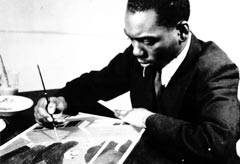




 |
 |
 |
 |
 |
||
|
|
|||||||||||||||||||||||||||||||||||||||||||||||
| Lawrence devised a
system to create each cycle. He laid out the panels on the floor of his
studio, designing rhythms of vertical and horizontal hardboard panels, each
the same size. In this way, the thirty to sixty panels of a series could
be seen together and painted at the same time. For his early narrative series, Lawrence first wrote captions and completed sketches for each scene. Later he drew directly onto gessoed hardboard panels. Then he systematically applied one color at a time to each panel, beginning with black and moving on to lighter colors. Lawrence often used his colors unmixed so that they would not vary from one panel to the next. He added white to make lighter shades of a color. His selection of colors–black and burnt umber to cadmium orange and yellow–created an overall unity and consistency. Lawrence repeated motifs, shapes, and words throughout his narrative series. In The Migration Series, the repetition of an enlarged single spike or nail, chain links or lattice, hands, and the hammer act as refrains in the lives, experiences, and struggles of African Americans. |
 Jacob Lawrence, 1941. Photograph by Kenneth F. Space. National Archives, Harmon Foundation, College Park, Maryland |
|||||||||||||||||||||||||||||||||||||||||||||||
©2002 Whitney Museum of American Art |